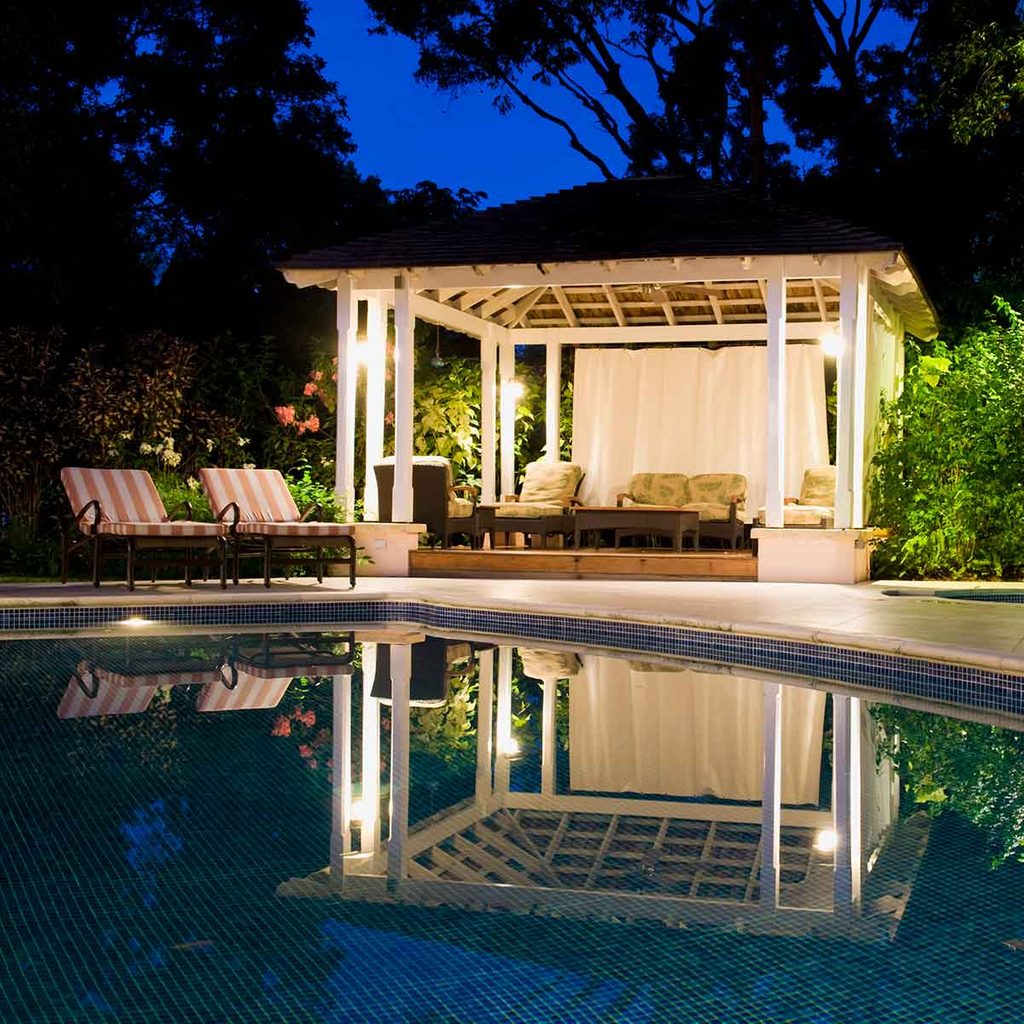Homeowner’s Guide to Cabanas
Updated: Apr. 28, 2023

Not just for VIPs! A cabana can complete your backyard retreat by providing a sheltered area for relaxing, changing and entertaining.
Our editors and experts handpick every product we feature. We may earn a commission from your purchases.
You finally have the backyard swimming pool of your dreams. What’s next? To amp up the enjoyment of your pool area and maximize outdoor time, consider a pool cabana.
While the idea might conjure images of VIPs lounging in a lavish private cabana at a fancy Las Vegas resort, poolside cabanas aren’t just for the rich and famous — they’re a great way to enhance your backyard pool experience. And depending on your taste and budget, pool cabanas can be simple temporary structures you can assemble in a few minutes, or elaborate built-ins with outdoor TVs, a wet bar and other perks.
Technically, you don’t even have to have a pool to enjoy a cabana. Similar to a gazebo, they can make a shady retreat for your backyard oasis.
To help you decide what is right for your private pool paradise, let’s examine the different types of poolside cabanas and what to consider when investing in one.
On This Page
What Is a Cabana?
A cabana is a covered shelter, usually adjacent to a swimming pool. It’s a place to get out of the sun, or an area to relax, change clothes or have a snack while enjoying the pool.
For some people, it provides a quiet space — maybe slightly out of earshot of kids splashing in the pool — or a place for friends to gather and kick back with a drink. Maybe it’s a shady spot to park the baby stroller while Mom and Dad enjoy the pool. No matter how it’s used, a pool cabana provides shade, relaxation and a little bit of privacy outdoors.
Are Cabanas Just for Poolside?
While technically different than a gazebo, pergola or pavilion (more on the differences below), a cabana can be any covered shelter in your backyard, a place to entertain guest or relax in the shade. Swimming pools aren’t a practical addition for every home; maybe your yard lacks the space or you don’t have time to undertake the care and maintenance. But a sheltered spot to kick up your heels is a welcome addition almost anywhere.
What Are the Different Types of Cabanas?
Some people refer to gazebos, pergolas, pavilions or pool houses as cabanas. But there are differences among all these structures. A gazebo lacks walls, a pergola has a trellis roof, and pavilions and pool houses are permanent and enclosed.
A true cabana is covered and enclosed on three sides, usually by solid or vinyl walls which may have windows or screens. Some variations may have fewer enclosures, but in all cases the main open side faces the pool. Cabanas come in essentially two versions:
A temporary cabana made of canvas or vinyl fitted over a metal or wood frame, which you put up for pool season and take down and store in the off-season.
A fixed cabana, typically a wood or masonry structure which may be wired for lights, TVs, ceiling fans and mini-fridges.
Pro and Cons of a Cabana
Whether you go with fixed or temporary, each type of pool cabana has its pluses and minuses.
Temporary Cabana Pros
- Inexpensive: Pop-up cabanas sell for as little as $150.
- Easy to assemble and take down: Pop-up cabanas can often go up in minutes and are usually just a two-person assembly job.
- Flexibility: A temporary cabana can be moved from place to place in the yard. For parties, it can function as a food and drink serving area.
Temporary Cabana Cons
- Easy to damage: Temporary cabanas usually come with vinyl or mesh walls that can tear easily.
- Weather risks: Even when anchored properly, temporary cabanas can be damaged or destroyed by high winds or other violent weather.
- May not be comfortable: If it has vinyl walls and no windows, a temporary cabana can be a hot and stuffy sun shelter.
Fixed Cabana Pros
- Permanence: A fixed cabana becomes part of your backyard landscape and doesn’t need to be taken down, folded up and stored in the off-season.
- Customizable: To a fixed structure, you can add electricity for a mini-fridge, lights and fans, and even plumbing for a sink or wet bar.
- Aesthetic appeal: Unlike a temporary cabana, a fixed cabana is usually made of wood and can be an attractive addition to your backyard.
Fixed Cabana Cons
- Expensive: A DIY version can run into the thousands of dollars, and installed cabanas can cost $15,000 and up. Plus, you’ll need outdoor furniture and other pool accessories to finish it off.
- Zoning: Even hidden in your backyard, a fixed structure probably requires a building permit from your municipality.
- Upkeep: Wooden cabanas periodically need to be stained and sealed, and windows and screens replaced. When the pool is not in use and the cabana is closed, you’ll need to keep unwanted critters from overwintering inside.
How to Choose the Best Cabana
The type of cabana you choose depends on how you intend to use it. Some points to consider:
- Space: How much pool deck or level yard do you have? How much are you willing to give up?
- Traffic: Can you locate the cabana so that it’s close to the pool yet doesn’t interfere with foot traffic?
- Climate: This may affect your choice in materials, as well as whether you go the fixed or temporary route.
- Value: Keep in mind that while an attractive permanent structure can add value and visual appeal to your property, it will require upkeep.
